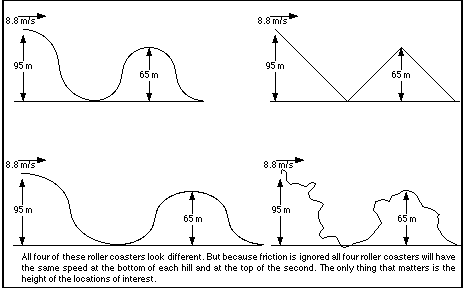The Most Often Used Calculations
A roller coaster is called a coaster because once it starts it
coasts through the entire track. No outside forces are required for
most coasters. (A few have double or triple lift hills and braking
sections.) Roller coasters trade height for velocity and velocity for
height. Most all calculations rely on using velocity measurements in
one way or another. The first step is being able to calculate the
changes in speed.
In an ideal world, mechanical energy is conserved. Frictional forces
are ignored in early design stages. (This document does not address
the nuances of dealing with frictional forces.) Mechanical energy on
a roller coaster comes in two basic forms. Kinetic energy, KE =
(1/2)mv2,
and potential energy, PE = mgh, due to gravity. Total energy, ET, is
conserved and is equal to the sum of kinetic and potential at any
single location.
ET = KE + PE (at any single location)

Calculation Algorithm to
calculate a change in velocity associated with a change in
height
Step 1 Identify two locations of interest. One with both a speed
and a height and the other location with either speed or height.
Step 2 Write an equation setting the total energy at one location
equal to the total energy at the other location.
Step 3 Solve for the unknown variable.
Example 1
What is the velocity at the bottom of the first hill?
Solution:
ET(TOP) =
ET(BOTTOM)
KE + PE = KE +PE
(1/2)mv2
+ mgh =
(1/2)mv2
+ mgh
(1/2)v2
+ gh =
(1/2)mv2
+ mgh The masses cancel out because it is the
same
coaster at the top and bottom.
(1/2)v2
+ gh =
(1/2)v2
+ gh Substitute the numbers at each
location
(1/2)(8.8)2
+ 9.8(95) =
(1/2)v2
+ 9.8(0) The height at the bottom is zero because
it is the lowest point when comparing to the starting
height.
38.72 + 931 =
(1/2)v2
969.72 =
(1/2)v2
1939.44 = v2
v = 44.04
m/s ...at
the bottom the the 1st hill.
Example 2
What is the velocity at the top of the second
hill?
Solution:
ET(TOP OF 1st
HILL) = ET(TOP OF
2nd HILL)
KE + PE = KE +PE
(1/2)mv2
+ mgh =
(1/2)mv2
+ mgh
(1/2)v2
+ gh =
(1/2)mv2
+ mgh The masses cancel out because it is the
same coaster at the top and
bottom.
(1/2)v2
+ gh =
(1/2)v2
+ gh Substitute the numbers at each
location
(1/2)(8.8)2
+ 9.8(95) =
(1/2)v2
+ 9.8(65) Notice all the numbers on the left side
come from the top
of the 1st hill while all the numbers on the right
side come from the top of the 2nd hill.
38.72 + 931 =
(1/2)v2
+ 637
332.72 =
(1/2)v2
665.44 = v2
v = 25.80
m/s ...at
the top the the 2nd hill.
This technique can be used to
calculate the velocity anywhere along the coaster.
If you use or find this page useful or have any
comments, please contact the author so maybe he'll do more.
Author: Tony Wayne
"ROLLER COASTER PHYSICS" TABLE
OF CONTENTS ... PHYSICS
PAVILION TABLE OF CONTENTS
<--PREVIOUS
SECTION ... NEXT
SECTION -->